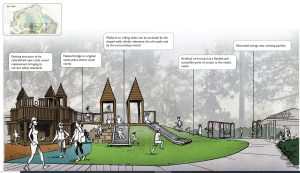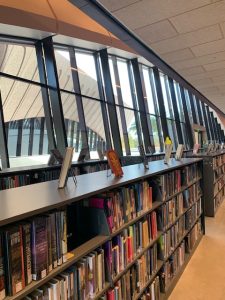Hefty increases for library and flood prevention included in CRA budget
The Winter Park Library will likely be able to add Sunday hours under the proposal that still needs final approval next month
Aug. 24, 2023
By Beth Kassab
An extra $5 million for flood prevention on the west side of Winter Park over three years along with $350,000 more for the Winter Park Library squeaked into the Community Redevelopment Agency’s annual $8 million budget on a split vote.
Mayor Phil Anderson, Vice Mayor Sheila DeCiccio, Commissioner Kris Cruzada and Orange County Representative Hal George voted in favor of the funding increases while Commissioners Marty Sullivan and Todd Weaver dissented.
The spending plan for the special district that covers downtown Winter Park still needs final approval by the board in September, when the city’s overall $200 million budget will come up for approval.
The plan also includes major upgrades for the playground at MLK Park near the library as well as permanent seating and restrooms in the West Meadow of Central Park that will serve the Farmer’s Market and other events.
The $5 million for stormwater improvements to help fix the drainage problems caused by Hurricane Ian last year will be diverted from money set aside to purchase the Post Office — an acquisition so far rejected by the U.S. Postal Service.
Anderson said the city could consider selling the old library on New England Avenue to raise cash if the Post Office ever came up for sale in the future.
Weaver made a motion to lower the amount taken from the CRA for infrastructure improvement from $5 million to $2 million. Weaver, Sullivan and George voted for the reduction, while DeCiccio, Anderson and Cruzada were opposed. The motion failed on the tie vote.
Commissioners say the money will now be available to address flooding as soon as repairs and projects are identified by an engineering study now underway.
The $350,000 increase in library funding will allow the facility to make significant additions in personnel, add hours on Sunday and grow the amount of programming offered to the public, Executive Director Melissa Schneider said at a recent commission meeting.
Weaver pressed Schneider on the library’s reported average monthly attendance figures, asking if people heading to the adjacent Events Center, but walking through the library, were being counted as library visitors.
Schneider insisted the increase from 10,000 monthly visitors in 2018 to 13,000 at the new library today are likely undercounted and that she is careful not to include foot traffic associated with the Events Center in the library’s totals.
Questions or comments? Email the editor at WinterParkVoiceEditor@gmail.com




I’m skeptical about what the reported number of Library visitors really tells us.
If someone walks in the Library, forgets their book, goes back to their car to get their book, walks in the Library again, or goes out to lunch or the office, and comes back later in the day, I presume they care counting the same person as multiple visitors.
This could happen more often than one might think.
Someone steps out to make a cell phone call for example.
Also the numbers don’t identify “chronic” library users versus infrequent, occasional, or periodic.
Nor do they identify Winter Park residents usage vs that of other surrounding municipalities and businesses.
If someone visits the library every day that person counts as 310 annual visitors in the Library’s count?
You have to wonder as these numbers are just thrown out there if it is more of a sales pitch for funding than it is an effort to meaningfully inform the Commission and the public about what is really going on at the Library and exactly WHO is consuming the lion’s share of library services in Winter Park.
The library has counted every visitor the same way for years and years. Every library in America counts people through the door. If the same person visits 8 times a day, that’s 8 visits. How could they possibly filter the numbers for cell phone calls, going to the car to retrieve something, etc? Based on the universal definition of library patrons, the numbers have increased nearly 15% from old library. The resident cards have almost doubled to 17,000. The classes are full and the children’s programming is always booked. Look at the August calendar on their website. Almost every class was booked to capacity. And September calendar show signs of 100% capacity in many programs, too.
If you’re wondering resident vs. non-resident attendance, call them up. They track the use.
If the additional funding becomes a burden to the city or attendance wanes, cut the funding next year. A smart fella once told me that when a church’s Sunday services and all their other classes/events reach 80% capacity, it’s time to expand the church. Obviously, the demand for more library services are there.
No need to throw out numbers. The library is super-successful “as is”. The additional funding is for more hours and more programming. If 50 open days a year are added, the numbers will tell all. Next year they can assess the numbers and base the funding on situation.
I have no problem with increasing funding of $350,000. If the numbers continue to grow they may need more funding!
Why wonder? Just visit the Library, sit down with the Executive Director and ask her to explain how the number of visitors and users are tracked.
Misplaced priorities here. Fix the brick streets. How many “visits” do we have on our brick streets daily? I’ll bet it tops the library by a bunch. We sure haven’t spent $50 million on our streets lately.
Why not add an online dimension to some of these classes that are filled up months in advance. That would significantly increase the amount of users without significantly impacting the library. I don’t see any online options at the library. It is a lost opportunity to reach even more community members who cannot attend for various reasons or find the class full. Library staff seems adverse to having an online option and I would hope some of the funding would go toward this option.